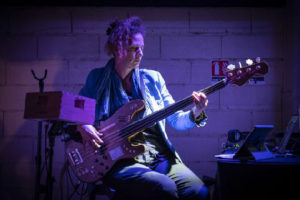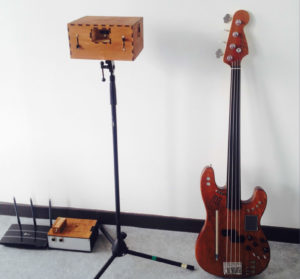Date/Time
Date(s) - 01/02/2020
6:30 pm - 8:00 pm
Categories

FloyKBass (FKB), A musical encounter between the FKBass, an augmented bass with integrated technology, and the Rudra Veena.
This project is supported by Institut Français, Institut Français in India and the Alliance Française de Pune. It is part of a research supported by the S3AM Department at IRCAM which sends one of its researchers, Robert Piéchaud, on a temporary assignment for the project.
Floy Krouchi will present the FKBass at IRCAM and ZKM, with the aim of entering a new phase of writing /composing for the instrument, as well as continuing her research on the modeling of the Rudra Veena and the spatialization of the FKBass.
Since 2012, Floy Krouchi has been working on the bass augmented by electronics through her
project Bass Holograms in collaboration with Cesare-cncm , for which she composed several
concert pieces (orders from the GRM, the Maison de la Radio , and various festivals in France, in
Europe and the United States). In 2016, she founded a set in New York, the “Bass Holograms
Ensemble”, a quintet (bass, cello, percussion, guitar, voice) for which she composed a 50-minute
piece that was presented in the United States following a creative residency, supported by the
Face Council for Contemporary Music.

In 2017, in partnership with Cesare-cncm and with the support of the FSIR (Arcadi Île de France), she designs an augmented bass with integrated technology . A presentation of this new instrument took place at IRCAM on December 05, 2018.The FKBass is an instrument with a double identity, at the same time traditional and contemporary.This work is inspired in part by her research trips to India with Pandit Hindraj Divekar, a master of the Rudra Veena. Rudra Veena is one of the oldest instruments in the classical Indian musical tradition that could be considered as the ancestor of the bass, as it has indeed the same number of strings and the same tuning. It was during these stays, and through the Rudra Veena that appeared to the composer the depth and amplitude of the low frequencies deployed in a very long time, and the way in which the ear re-composes by itself the frequencies induced but not present in the acoustic space. The notion of sound hologram comes from this physical and sensory effect by which the ear re-composes a sound spectrum that does not exist.The artistic and spiritual approach of the ragas, the audible and induced sound frequencies of the Rudra Veena because of its acoustic properties (17 seconds of sustain), have therefore greatly influenced her creative work. These influences led her to the concepts of “Bass Holograms” and “electronic raga” revealed through her instrument, the fretless electric bass thanks to an electronic lutherie system.
Robert Piéchaud
Passionate about a wide spectrum of music , Robert Piéchaud has been a collaborator of IRCAM
as a research engineer since 2012 (Instrumental Acoustic Labs then S3AM), notably on Modalys
technologies (sound synthesis by physical models) and Snail (musical representation of the sound spectrum), as well as on hybrid instruments (Coala) and the active control of musical instruments.He is also interested in music typography and has designed a large number of fonts for publishing, from Gregorian chant to the most contemporary notations. His piano repertoire,
extending from Couperin to the 21st century, also reflects his curiosity and openness, with an
important part left to improvisation (film-concerts). As a composer, he favors the voice and the
acoustic instruments, as evidenced by his last piece, the stringed septet Metamorphoses on a
theme of W. Rihm created at Radio France in December 2018. In the Microtonal Studies project, in constant dialogue with the musicians, Robert’s expertise and ear will be at the service of the
modeling of traditional instruments and practices, as well as the implementation of
these models and tools in contemporary lutherie at stake in Floy Krouchi’s FKBass. As
part of this project, he will develop a specific virtual model of Rudra Veena under Modalys,
closely following its characteristics: materials, sympathetic strings, resonators, frettage,
temperament, etc. For the sound analysis and representation part (The Snail technology), a tailor-made prototype will be developed to account for the tuning techniques, the temperament and the appointment of notes and intervals specific to Northern music in India. These prototypes will be demonstrated and explained during the workshop planned at the end of the project.
The augmented bass project was also born of a practice and a reflection of the composer on the new lutheries:Influenced by the electroacoustic and the real time, Floy Krouchi brings with the FKBass her vision of the hybrid lutheries marrying physical instruments and electronic extensions. These new lutheries are undeniably one of the major challenges of (in) contemporary
creation: they raise new paradigms for writing and composition, renew the instrumental gesture and spark new modes of play. Thus, the central axis of research on the increased bass focused on the integration of sensors and controllers to the instrument itself.
WE SHALL UPDATE SOON THE TIMINGS SOON
 Alliance Francaise de Pune Alliance Francaise Network- INDIA
Alliance Francaise de Pune Alliance Francaise Network- INDIA
